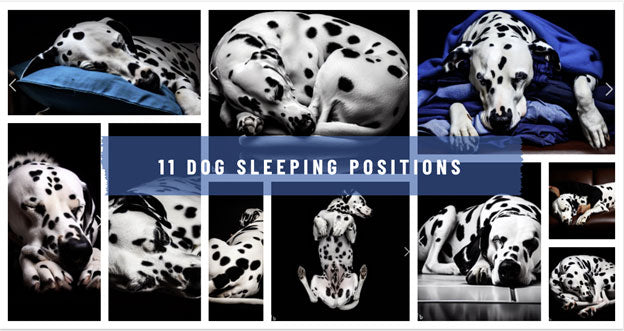
Can Dogs Watch TV? Unveiling the Truth Behind Canine Couch Potatoes
Disclaimer: Some of the links in our blog posts are affiliate links. This means we may earn a small commission if you make a purchase through them which helps support our blog, at no extra cost to you.
Welcome to the wonderful world where our furry friends collide with the magic of television! Have you ever noticed your canine companion glued to the screen, wagging their tail, or barking at what's playing? It's a sight that always brings a smile to our faces. But have you ever wondered what happens in their adorable little heads when they're engrossed in the on-screen action?
Grab a bowl of popcorn (or maybe a treat for your furry friend), cozy up on the couch, and prepare for a journey like no other. Join us as we uncover the science, quirks, and undeniable joy from witnessing our canine companions indulge in prime-time entertainment. It's time to delve into the fascinating realm where dogs and television intertwine, where canine curiosity meets the captivating allure of the small screen. Get ready to laugh, marvel, and gain a deeper understanding of our beloved companions' unique relationship with the world of entertainment. Get ready for a paw-some adventure into the quizzing questions, ‘do dogs watch TV?’ or ‘do they understand the movement on TV?’.
Do Dogs Watch TV?
This question has sparked curiosity and amusement among pet owners and researchers alike. We've all witnessed those moments when our furry friends seem utterly captivated by what's happening on the screen, wagging their tails or even barking in response. But do dogs truly comprehend and enjoy television as we do, or are they simply reacting to the sounds and movements?
To understand this phenomenon, we must consider our canine companions' sensory and cognitive abilities. Dogs possess a remarkable sense of hearing and vision, which allows them to perceive a wide range of sounds and detect subtle movements. However, their visual system is different from ours. While humans can perceive high-definition images and a broad spectrum of colors, dogs have dichromatic vision, which means they see the world in shades of blue and yellow. This distinction raises the question of how dogs perceive the images and colors on television screens.
Several studies have attempted to unravel the mystery of dogs and TV watching. Researchers have found that dogs do react to television stimuli. The level of interest and engagement varies from dog to dog, with some displaying a keen interest while others showing indifference. The reactions can include barking, tail wagging, head tilting, or even attempts to interact with the images on the screen.
One possible explanation for dogs' interest in TV is their ability to detect and respond to certain sounds and movements. Dogs have an acute sense of hearing, capable of picking up frequencies beyond the range of human hearing. Heightened auditory perception allows them to catch subtle cues from the television, such as the sound of other animals, doorbells, or sirens. Additionally, dogs have a keen sense of motion detection, which means they can notice rapid movements on the screen that may grab their attention.
However, it's essential to note that dogs' comprehension of television content is limited. Due to their visual system and cognitive differences, they may not fully understand the narratives or follow intricate storylines. Dogs' reactions to TV are more instinctual and immediate, driven by their heightened sensory perception rather than a deep understanding of the displayed content.
While dogs may enjoy watching television to some extent, it's crucial for pet owners to moderate and select appropriate content. Now, specially designed TV shows and videos cater to dogs' interests, featuring stimulating visuals and sounds that appeal to their senses. These programs often incorporate nature scenes, animals, and soothing sounds, providing entertainment and relaxation for our canine friends.
So, the next time you catch your furry companion fixated on the screen, feel free to indulge their curiosity and provide them with appropriate entertainment. Just remember that while dogs may not fully comprehend the intricacies of TV shows as we do, their interest and engagement add a delightful touch of entertainment to our shared experiences. So, grab a cozy spot on the couch, press play, and enjoy the company of your canine companion as you embark on a TV-watching adventure together.

____________________________________________________________________________________
Explore our collection of movies and TV-themed pet portraits, they are the perfect gift for any pet lover!
____________________________________________________________________________________
Should You Leave the TV on for Your Dog?
Whether or not to leave the TV on for your dog is a decision that depends on various factors and individual circumstances. Here are some considerations to help you make an informed choice:
- Separation Anxiety: If your dog experiences separation anxiety or gets stressed when left alone, leaving the TV on can provide background noise that may help alleviate their loneliness. The familiar sounds and voices from the television can provide comfort and make them feel less isolated.
- Noise Sensitivity: On the other hand, if your dog is sensitive to noise or easily overwhelmed, having the TV constantly on may increase their anxiety. It's important to gauge your dog's response to the TV noise and ensure it doesn't cause distress or lead to behavioral issues.
- Content Selection: The type of content playing on the TV matters. Some dogs may enjoy watching nature shows or videos specifically designed for dogs, featuring calming visuals and sounds of nature. However, programs with loud or intense sounds, fast-paced action, or aggressive behavior may harm your dog's well-being.
- Energy Consumption and Safety: Having the TV on for extended periods can increase energy consumption and potential safety hazards. If you leave the TV on, ensure it is in a safe location where your dog can't accidentally knock it over or access any cords or cables.
- Individual Preferences: Dogs have varying preferences, and not all are interested in watching TV. Some dogs may be indifferent to the screen, while others show genuine interest. Observe your dog's behavior and response to determine if leaving the TV on is beneficial or enjoyable for them.

Ultimately, assessing your dog's needs and temperament is essential. If you find that leaving the TV on helps to calm your dog, reduce anxiety, or provide a sense of companionship, it can be a suitable option. However, if your dog shows signs of distress or agitation in response to the TV, explore other methods such as providing interactive toys, engaging in pre-departure routines, or seeking professional guidance. Consulting with a veterinarian or a professional dog behaviorist can offer personalized advice based on your dog's situation.
Why Do Some Dogs Watch TV and Others Don't?
The interest or lack of interest in watching TV can vary among individual dogs, and several factors can contribute to these differences:
- Visual Sensitivity: Dogs have different visual sensitivities. Some dogs may be more responsive to visual stimuli and able to perceive movements on the screen more clearly. Dogs with better visual acuity or those more visually inclined may find TV more engaging.
- Breed Characteristics: Different dog breeds have distinct traits and tendencies. Some breeds are known to be more visually observant or have a higher prey drive, which could make them more likely to show interest in TV. For example, herding or sporting breeds bred for visual tasks may be more inclined to watch moving images on the screen.
- Individual Personality: Just like humans, dogs have unique personalities. Some dogs may be naturally curious about exploring new stimuli, including the TV. Others may be more laid-back or less inclined to focus on visual stimuli. Each dog's personality will play a role in determining their level of interest in TV.
- Environmental Factors: The environment in which a dog grows up can influence their responses to various stimuli, including TV. Dogs exposed to TVs or screens from a young age may be more familiar with the concept and show greater interest. On the other hand, dogs with limited or not been exposed to TVs may not understand or find them appealing.
- Previous Experiences: Dogs may have had positive or negative experiences associated with TVs or the sounds and visuals they produce. Suppose a dog had a negative experience, such as a loud noise or a startling event while the TV was on. In that case, they may develop a negative association and avoid or ignore the TV.
It's essential to remember that dogs are individuals, and their preferences and reactions to stimuli can vary. While some dogs may actively watch TV, others may not find it engaging or have different interests. If your dog doesn't show interest in TV, it doesn't necessarily indicate a problem. Providing alternative forms of mental and physical stimulation tailored to their preferences and needs can benefit their overall well-being.

TV Shows for Dog
DOG TV is an exclusive channel designed to alleviate your pup’s stress and anxiety throughout the day. The first channel to bring relaxing videos and music for dogs, created specifically for a canine audience.

Relax My Dog is a YouTube channel that specializes in music and TV designed to help any dog breed overcome a variety of problems.
Here is a video from YouTube which has 15 million views. It has sounds of nature which Dogs love!
Here is another video from YouTube which features footage of squirrels scurrying and playing, set to engaging sound effects, allowing dogs to indulge their instincts from home comfort.

TV For Dogs: Can Dogs Learn From TV?
While dogs may show interest in television and react to the sights and sounds they perceive, their ability to learn from TV is limited. Dogs primarily rely on their sense of smell and interactions with the physical world to learn and understand their environment. While dogs have visual abilities, their vision differs from ours, and they may have difficulty perceiving two-dimensional images as representations of reality.
Dogs have a lower visual acuity and perceive fewer frames per second than humans. This means that the rapid movements and fluid visuals we perceive on television may appear flickering or disjointed to dogs. They may struggle to make meaningful connections or understand the context of what they see.
However, some dogs may still benefit from certain aspects of television. For example, they may learn to associate certain sounds or music cues from TV programs with specific life events or activities. Additionally, TV can provide auditory stimulation or relaxation through calming sounds or music.
It's important to note that while dogs may not learn as humans do from television, they can still be entertained by certain types of content and may react to visual or auditory cues on the screen. However, dogs are more likely to rely on real-life experiences, training, and interactions with their environment and human caregivers for active learning and understanding.

We hope you had a good time reading about dogs and TV! If you're looking for some cool and fun gifts for the pet lover in your life, be sure to check out our custom pet gifts. They're totally unique and guaranteed to bring a smile to their face.
Popular Blog
7 Unique Products That Every Dog Owner Will Love
Let’s be honest, our dogs run the house. They make us laugh, steal our socks,...
50 Funny Dog Birthday Puns for a Tail-Wagging Good Time!
Here is a delightful collection of 50 dog birthday puns guaranteed to bring s...
Homemade Dog Toys Your Pooch Will Love: Top 10 DIY Delights
Pet toys, especially safe dog toys, can be expensive and don’t last too long....
Canine Companions Worldwide: Modern Treatment & Taxes for Dog Owners
The intricate relationship between humans and dogs is a testament to a profou...











